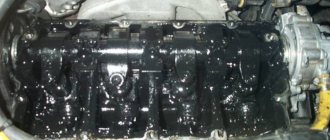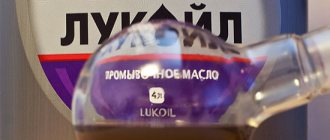Oil darkens, it means something is wrong, some car owners think. But is this really so? After all, it’s one thing when it quickly turns black after replacement (still almost fresh), and another thing if after a couple of thousand kilometers.
There are several reasons why this happened - poor-quality lubricated fluid, dirty condition of the engine, long mileage of the car without replacement, switching to higher quality oil, overheating, even due to bad fuel. How do you know when engine oil quickly darkens is good and when it’s bad? After all, this is not always a negative consequence and you need to worry. Then be sure to pay attention to additional factors and check the quality of the oil.
Gradual aging and darkening is a natural process . Therefore, the main task of the car enthusiast is to figure out whether the darkening is caused by positive or negative factors.
It's not just engine parts that wear out
During the operation of a car, gradual wear of its components, especially the engine, occurs, and no matter how much we would like to prevent this, we cannot succeed. In this case, not only components and mechanisms are subject to wear, but also the working fluids poured into it.
Therefore, the list of engine maintenance work includes the replacement of technical fluids. It is especially important to change engine oil on time.
All automobile manufacturers indicate in their technical documentation what frequency should be between changing a given working fluid. But many motorists are accustomed to independently determining whether they can continue operating the engine with oil filled or whether it is time to replace it.
And they do this based on the color of the liquid - if the oil has become very dark, then it’s time to buy a new one and replace it.
Next, we will try to figure out whether the darkening of the oil is really a signal that it is time to go to the store for a new one, crawl under the car, or leave the replacement operation to specialists at a service station.
Consequences of long-term driving on black oil
The roots of the misconception of many motorists regarding the color of MM, which manifests itself in the form of aversion to the black color of the lubricant, should be sought in the Soviet past, when the quality of the oil was directly associated with its color, and this was fair. But it was a long time ago. Today, even outright counterfeit products have a transparent consistency and a light shade.
If, after long-term operation of the engine, the oil darkens slightly, this indicates either that the engine is not very dirty, or that the alkalinity level is not high enough. In the latter case, the lubricating properties of the liquid are not affected in any way, but the cleaning properties are frankly insufficient.
Dark MM indicates that it properly performs cleaning functions, but the functionality of such a lubricant is sharply reduced. If you continue to drive with such oil, it will no longer be able to wash away pollution products from the surface of the power unit parts, contributing to the thickening of the carbon layer on key engine components.
Consequences of blackening engine oil
Why does engine oil turn black?
Let us immediately note that in any case, during operation, the oil will turn black, but this can happen for various reasons. First, let's look at the lubricant itself.
Modern oil for an internal combustion engine is a multicomponent liquid that must perform a number of important functions inside the engine.
The first is the creation of an oil film between surfaces to reduce friction between them. This film is formed during the process of lubrication of these surfaces.
The second function is to remove heat from the rubbing elements. While the engine is running, its components still rub, causing them to heat up. And if the heat is not removed, then due to excessive temperature the metal will begin to expand, which leads to jamming of the assembly.
And the third function is washing surfaces to remove wear products and dirt. All due to the same friction, small metal shavings are formed, which later act as an abrasive, increasing the wear of surfaces and the engine as a whole.
Dirt also acts in the same way. Gases escaping from the cylinders into the crankcase also carry polluting elements such as soot - and it is not desirable for them to settle on working surfaces.
And if metal shavings and dirt often settle to the bottom of the crankcase after flushing or are retained in the filter, then the oil dissolves the soot and retains it. For this purpose, it contains alkaline detergent additives.
Alkali is a universal solvent and acid neutralizer, and its presence in the lubricant prevents soot and other contaminants from settling on the surfaces of components. And since they do not settle anywhere, but linger in the oil, they will ultimately lead to a change in the color of the oil - its darkening.
When dark oil is normal
The automotive lubrication system is a closed, sealed circuit. Draining into the crankcase, the oil is then delivered by a pump to the main channels passing through the lubricated parts. Along the way, it absorbs oxides, mechanical particles formed during friction, as well as carbon deposits, and returns to the crankcase. It is not surprising that, constantly enriched with various pollutants, it darkens.
Since the parts of the power unit operating in extreme speed conditions become very hot, a significant part of the heat is transferred to technical fluids - antifreeze and engine oil. The latter can heat up to temperatures exceeding 100°C. This is good for the lubricant - it becomes more fluid, which allows it to penetrate into technical gaps, reducing friction and washing away fresh carbon deposits that have not yet coked. This natural darkening is called “oil work.”
So if, after prolonged use, the MM has practically not changed its color, they say that the lubricant does not work. At least this concerns its cleansing characteristics. In this case, all deposits remain on the walls of the engine, forming a rather thick layer of indelible carbon deposits, which, firstly, changes the size of the technological gaps and the geometry of engine components, and secondly, impairs the heat transfer of the power unit, which leads to prolonged operation at elevated temperatures . Figuratively speaking - to overheating. Consequently, the car owner uses a frankly low-quality product, a fake, which reduces the life of the engine.
Black oil in the engine is not a cause for concern if the dark color acquired gradually over the regulatory interval. Thus, if the lubricant after driving 5,000-10,000 kilometers has generally retained its original performance characteristics, but has darkened, this is normal, this is an indicator that the oil used is appropriate for the specific engine.
If the oil in the engine turns black, this only means that all pollutants, including compounds spent during the combustion process of fuel assemblies, enter the lubricating fluid without lingering on the walls of the working area. This protective ability of motor oil minimizes the likelihood of oxidative reactions occurring inside the power unit, increasing its service life. During a scheduled oil change during the next maintenance, all substances washed out by the lubricant are drained, and clean oil is poured into the system.
How quickly should the grease turn black?
Many people wonder what color the oil should be at different mileage.
It is impossible to say unequivocally that with such and such a mileage its color should be this color, and with more mileage it should not change more, since this depends on several factors:
- lubricant quality;
- its additive package;
- technical serviceability of the power plant;
- the degree of wear and contamination.
Let's assume that the engine is new and technically fully functional, and the change in color depends entirely on the oil and its composition.
When using high-quality oil, its darkening will not occur earlier than after several thousand kilometers and this process will be gradual.
But here too there are many nuances.
Motor oil may contain different amounts of detergent alkaline additives.
So, in a lubricant with a low alkali content, the flushing process will be slow, and, therefore, the oil will turn black later.
Conversely, with a large amount of alkaline additives, the removal of pollutants will be more intense, and the material will darken earlier.
But in any case, the oil will darken and this is not a sign that it is time to change it, unless, of course, its service life has been exhausted. This is rather a signal that the material is of high quality and performs its functions.
But the lack of darkening after long-term use is not a good sign - the oil does not flush, and dirt settles on the surfaces. In this case, it is better to replace it with another type of working fluid.
It is worth noting that you should not use the lubricant for longer than that specified by the car manufacturer.
The fact is that the oil uses up its additives as it operates and eventually ceases to perform its functions, including flushing.
As a lubricant ages, it will be less able to remove contaminants from surfaces. These, in turn, will begin to affect heat transfer and friction.
By settling on the walls of the oil channels, dirt and soot will reduce their diameter and throughput. If you do not replace the lubricant in a timely manner, this will ultimately lead to coking - the contaminants on the surface will become so dense that the new lubricant simply will not be able to wash them off, and all this will affect the life of the power plant - major repairs will have to be carried out earlier.
The engine oil quickly turned black
As already mentioned, darkening of the oil indicates that it is working, that is, it is actively cleaning the engine of contaminants. At the same time, it also happens that the oil does not just darken, but becomes black and more like fuel oil. In this case, you should pay special attention to this point and find out why the engine oil quickly turns black.
- At the very beginning, you need to remove the oil dipstick and wipe off the oil with a clean rag. Remains of black streaks will indicate that the lubricant in the engine is burning out. The reason may be significant wear of the CPG, that is, oil enters the combustion chamber. At the same time, the fuel also flows into the engine housing, diluting the lubricant. As a result, the working fluid of the internal combustion engine lubrication system loses its protective, cleaning and other beneficial properties. It turns out that rapid blackening of the oil indicates problems with the engine itself. Additional symptoms are usually increased fuel and oil consumption, decreased engine power, smoky exhaust, difficult cold starting, etc.
- The second reason that explains why the oil in a diesel engine quickly turns black or the lubricant turns black in a gasoline unit is overheating of the oil. A rapid change in color to black occurs if the engine is constantly operated in difficult conditions at high speeds and maximum loads. Also, the oil overheats when the lubricant was initially selected incorrectly according to its viscosity characteristics. In fact, boiling occurs and the lubricant becomes a homogeneous black mass.
It becomes clear that in case of problems with the CPG, the engine needs repair. If the oil is not suitable for a given type of engine, then such lubricant must be immediately replaced with a suitable option, which is recommended by the engine manufacturer and meets all tolerances. Do not also forget that a low-grade fake may be accidentally poured into the engine. For this reason, it is recommended to purchase fuels and lubricants only at trusted points of sale.
Remember, further operation of the engine with black oil can lead to serious damage to the power unit in the absence of existing problems, as well as additional problems when postponing repairs and replacement of lubricant on units in which blackening of the oil is noticed due to wear of individual elements.
Effect of motor malfunction on lubricant color change
We only looked at the oil, and found that the latter will darken as we work. The condition of the engine also affects the color change of the lubricant.
Wear of the cylinder-piston group will lead to a significant increase in the amount of gases escaping from the cylinders, which will cause a faster change in the color of the engine oil.
If the power system in a gasoline engine is misregulated, the darkening will occur even faster.
For example, due to incorrect adjustment, an enriched combustible mixture is supplied to the cylinders. Due to the large amount of fuel, this mixture will not be able to fully burn in the cylinders, which will result in the formation of soot that settles on the cylinder walls.
The oil, washing the walls, will wash away this soot and keep it in itself, while quickly darkening.
In diesel engines, the lubricant will change color much faster than in a gasoline engine, even if the engine is fully operational. The reason for this is the peculiarity of the fuel system and the fuel used in these engines.
Diesel fuel produces significantly more soot during combustion. Some of it will enter the crankcase along with the escaped gases. Because of this, the oil in diesel engines turns black faster.
As a short summary, we note the main reasons on which the rate of darkening of the oil depends:
- The amount of detergent additives in the composition of the lubricant (With a small amount of these additives, the darkening will occur gradually, since the alkali will not wash away contaminants intensively, but a large number of cleaning components in the lubricant will ensure faster washing and removal of dirt, but because of this the oil will be faster will darken);
- Cleanliness of the engine (A lot also depends on this. For example, the engine used low-quality oil, which did not wash away dirt well, and a large amount of it settled on the surfaces inside. Then the oil was replaced with a high-quality one, with a good additive package. Detergent components of the new lubricant will begin to actively remove dirt, causing the oil to quickly turn black);
- Technical serviceability of the engine and the degree of its wear (A serviceable and unworn engine will have a gradual darkening of the lubricant. A worn-out unit, in which the operation of the power supply, ignition or gas distribution system is disrupted, will very quickly cause a change in the color of the lubricant).
At the same time, we also found out that darkening of the oil is a natural process, and you shouldn’t be afraid of this, especially since this is a good indicator if the color change occurs gradually and you can continue to drive the car calmly.
It is much worse if the lubricant does not change its color; this can have a negative impact in the future, since dirt can clog the channels, leading to oil starvation of components and mechanisms. As a result, the engine may seize.
If the oil turns black after just a few tens of kilometers, then this is something to think about. This can happen after changing the brand of lubricant.
For example, at first a low-quality fluid was used, which is why large amounts of pollutants accumulated inside the engine. After filling in a good lubricant, it began to actively wash away the dirt.
In this case, you can do differently - use an engine flush or continue to use the filled oil, but significantly reducing the mileage until the next replacement, for example, not 10 thousand km, but 5 thousand.
In this case, it is advisable to periodically change the oil filter. This will slightly reduce the amount of dirt in the oil.
The second option in case of rapid darkening is severe wear of the engine and the need for major repairs or improper operation of its systems.
To understand the reason for the rapid blackening of the lubricant, first of all, it is necessary to check the performance of the engine systems, and also measure the compression, which will make it possible to understand why the lubricant quickly changes color - from malfunction and wear of the engine, or from the oil itself.
Gradual engine cleaning
As we found out, a change in the shade of the oil is the result of the ingress of pollutants formed in the engine during its intensive operation. High-alkaline additives also make their contribution. A color that is too dark does not mean that there are problems with the power unit; this is a completely normal natural process, but if the MM becomes very dark, it should be replaced along with the oil filter, without waiting until the numbers corresponding to those given in the operating manual appear on the speedometer. If your goal is to gradually clean the engine of accumulated contaminants, change the oil filter not only when changing the oil, but also in between, at least once. It's not such an expensive method that you shouldn't try it.
Draining the black MM from the engine
It is safe to say that slow cleaning of the engine from suspended microparticles is much more useful than the express method based on the use of detergent additives with aggressive components, which, when mixed with oil, worsen its technical parameters (in particular, viscosity).
More liquid lubricant flows faster into the sump, without lingering in the working areas, which causes faster wear of engine components that need high-quality lubrication.
Many car owners refuse the gradual cleaning method, considering it too expensive. In fact, more frequent replacement of the MM will initially lead to the fact that over time it will become dirty much more slowly, returning to the indicators that were observed when the power unit was young.
For old, heavily worn engines, one of the most typical causes of accelerated darkening of the lubricant is the ingress of combustion products, that is, crankcase gases, into the oil. This problem is easily diagnosed, since this process is accompanied by the appearance of a very specific and recognizable smell of burnt MM in the engine compartment. This will also be evidenced by an increase in its consumption, as well as an increase in fuel consumption.
The problem is treated by replacing the piston rings, and in especially severe cases, by replacing the boring sleeves, which allows them to be given their original standard dimensions.
Another good way to prevent premature contamination of the lubricant is to regularly top it up when the level decreases, until it is time for a scheduled replacement.
Most experienced car owners claim that when using high-quality lubricating fluid, it begins to darken after fairly significant runs, about 7-10 thousand kilometers. If the initial alkalinity index is high, when such oil darkens, no destructive processes occur in the engine. The dark color in this case is evidence that the lubricant managed to absorb the maximum amount of harmful deposits accumulated on the surface of the engine parts. There is no need to rush into replacing; carry out this activity in accordance with the recommended dates.











